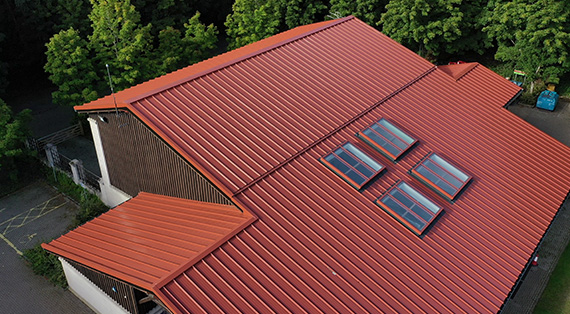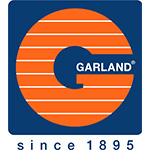Common Roofing Defects And How To Avoid Them
In this article, Garland UK’s Head of Technical, Mark Fisher, will look at the most commonly encountered problems and how they can be avoided.
The best way to avoid roof defects is to gain a better understanding of the commercial roofing systems available on the market today. We’ll explore four of the most commonly specified general systems:
- Modified Bitumen Membranes
- Metal
- Cold-applied Liquid Coatings
- Green Roofs
We’ll briefly cover their advantages/disadvantages and the applications to which they are suited, before looking at the most common design and application defects, and how these can be avoided.
Types of roofing systems
Modified Bitumen Membranes:

Metal - There are three main typical metal roofing systems:
- Traditional Metal Cladding:

- Composite Metal Panels:

- Standing Seam:
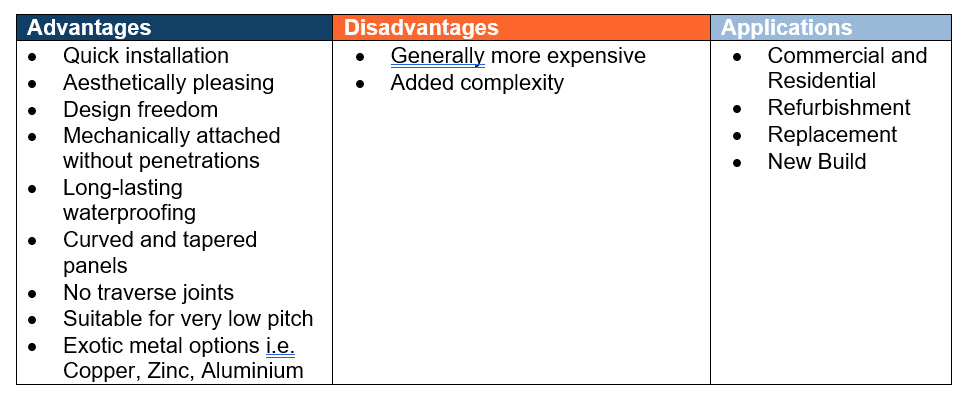
Cold-applied Liquid Coatings:
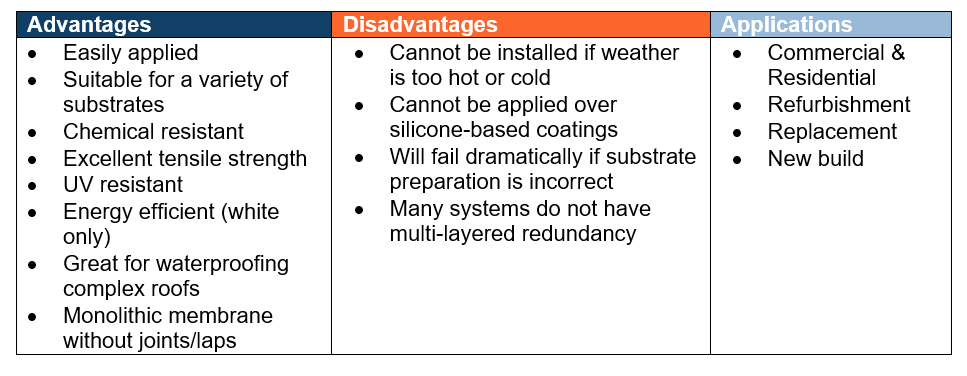
Green Roofs - There are two variations of Green Roofs, extensive and intensive:
- Extensive Green Roofs:
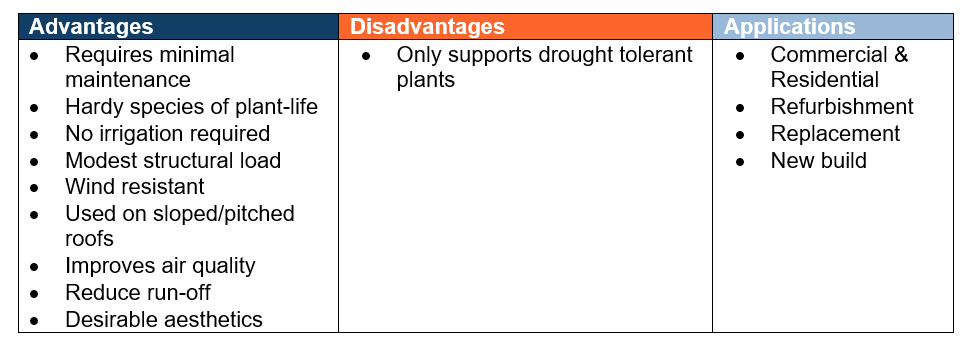
- Intensive Green Roofs:

Common Roof Design Defects
There are a number of common roofing defects that are caused at the design stages of a project. Each roofing system has its own particular design considerations, but there are some general design issues that should be kept in mind across all roofing systems:
- Structural Issues - When the existing structure is questionable it is recommended that a detailed structural survey is carried out before any roof replacement or refurbishment works.
- Thermal Performance - If an existing roof element does not meet the current Building Regulations then increasing its thermal properties is an essential and necessary requirement.
- Sufficient Falls and Drainage - Good drainage is essential to the success of any roof. A lack of positive drainage will cause water to pond on the waterproofing surface. Flat roofing systems should be designed to 1:40 with a view to have a finished fall of 1:80. Drainage including guttering and other rainwater dispersal systems must be designed to comply with BS EN 12056-3:2000, Gravity drainage systems inside buildings.
- Pitch - Flat roofs should not actually be flat, it would be more accurate to call low sloped roofs. The current British Standard, BS 6229:2018 Flat roofs with continuously supported flexible waterproof coverings, dictates that all flat roofs should in fact be designed with a pitch between 1:40 and 1:80 as a minimum.
Modified Bitumen Membranes - Although the majority of modified bitumen membranes in the UK use the same basic set of ‘ingredients’ or formulation, it is important to know the differences in the specification. The important factors are:
- Low-temperature flexibility - Allows the waterproofing to comfortably expand and contract at low temperatures but it is also a very important gauge on the amount of modifier in the bitumen compound. Generally, the higher the percentage of modifiers the better performing the membrane.
- Reinforcement tensile strength - The stronger the reinforcement within the membrane, the better it is able to cope with the expansion forces and other stresses. Generally, the higher the number the better, but dimensional stability and elongation also have to be taken into account.
Metal
- Roof pitch - Some standing seam systems are capable at pitches of 1.5 degrees. Most will require at least 4-6 degrees of slope, otherwise, leaks will become apparent at laps and joints in the metal panels.
- Wind uplift and loading - Especially important with metal systems that are self-supporting and fixed to a subframe or steel purlins. The profile, gauge and material will determine the strength of the metal panel, and should be considered along with the span the panel is expected to bridge and it’s subjected loading.
- Fire resistance - Metal roofs are generally resistant to the spread of and penetration from fire. Steel or aluminium roof sheet with less than 200g per square meter of organic coating automatically complies to building regulations, with a Broof T4 classification without testing under European Standard EN13501-5, Fire classification of construction products and building elements - Classification using data from reaction to fire tests.
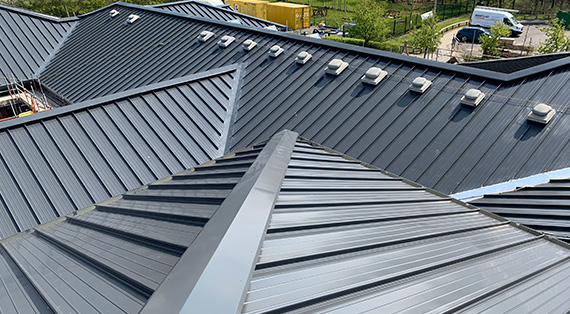
A fire strategy should be in place or a fire engineer should be involved in the project. Not only is the design stage important to get the right plan but also needs to be checked to be installed properly as per the plan.
- Incompatible materials - Different metals tend to react poorly with each other; e.g. copper and zinc placed together cause bimetallic corrosion, also known as galvanic corrosion, which is similar to the chemical reaction that powers batteries!
Cold-applied Liquid Coatings - should be treated in a similar vein to other systems. Roof slope, drainage and fire considerations should be kept in mind. Also:
- Incompatible materials - Must again be avoided, e.g. polyurethane or acrylic coatings must not be used over methyl methacrylate (MMA) covering in a refurbishment project and silicone-based materials are generally incompatible with all other coatings.
- UV stability - There are products designed for internal use, that if used externally would break down as a result of the UV radiation.
- Odour - Some coatings can be pungent during application which can be problematic on sensitive sites such as hospitals or schools, where low odour coatings should be specified.
Green Roofs
- Roof pitch - Whilst Intensive Green Roofs can be installed on a flat roof deck with suitable drainage, for Extensive Green Roofs generally a minimum fall of 1:60 is desirable. The growing medium and drainage system must be designed to keep the vegetation above any standing water.
- Wind uplift - must be factored into the design. One solution is to install a pebble band or paving around the perimeter of the roof. This has the additional benefit of acting as both a vegetation and fire barrier.
- Waterproofing - Must extend a minimum of 150mm above the vegetation layer at abutments, parapets or penetrations through the roofing surface. Waterproofing must also be root resistant, otherwise a root barrier must be installed in compliance with BS EN 13948:2007 Flexible sheets for waterproofing - bitumen, plastic and rubber sheets for roof waterproofing - determination of resistance to root penetration.
- Shade and rain shadow – Must be considered from any adjacent structures. Sunlight and rain are essential to the continued health of the vegetation.
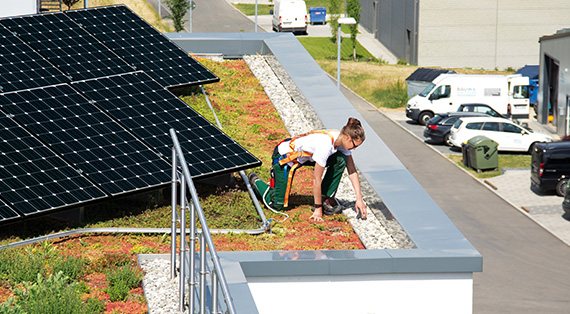
Common Roof Design Defect – Solutions
There are some general points to keep in mind that will ensure that roofing design defects do not occur.
It is always paramount to have assessed and designed out, or mitigate any risks. This is a statutory obligation under the Construction (Design and Management) Regulations (CDM) 2015.
Compliance with Building Regulations can help to guarantee that your roof is defect free. The following Building Regulations are relevant to any roofing project:
- Approved Document B – Fire Safety
- Approved Document F – Ventilation
- Approved Document H – Drainage and waste disposal
- Approved Document K – Protection from falling, collision and impact
- Approved Document L – Conservation of fuel and power
The best way to ensure your roof is well designed is to get expert advice. Your roofing manufacturer will have a wealth of experience specifying and designing roofing systems and can help you navigate the challenges we’ve covered.

Common Roof Application Defects
There are a number of common roofing defects that are caused at the installation stages of a project. Some general application issues that affect all roofing systems are:
- Weather - Dry conditions are essential so moisture is not trapped within the roofing system once complete.
- Insulation type - Should be considered in general; e.g. with Modified Bitumen Membranes suitable insulation should be used if a torch on application is intended, as non-compatible products could affect adhesion, and/or be a fire risk.
Modified Bitumen Membranes
- Ambient temperature - In lower temperatures self-adhesive membranes can become difficult to install or worse fail to bond. Hot-air guns can be used to heat the membrane so application is easier and more secure.
- Head laps – For torch-on applications, head laps must be sufficiently bonded, with a minimum lap of 100mm on the head lap or 150mm at any details, and a minimum 75-80mm for side laps. Head laps should be laid in a break bond pattern to assist with thermal expansion/contraction helping to ensure that splits so not occur.
- Sloped/vertical surfaces – Must be mechanically fixed.
Metal
- Insufficient sealing of joints/head laps - This will inevitably cause water to ingress in the future.
- Incorrect fixings/fasteners - The roofing manufacturers suggested fixings/fasteners must be used. A stainless steel non-corroding specification is used in most high-end systems.
- Insufficient fixings - Ensure that the manufacturer’s installation instructions are followed with reference to fixing frequency.
Cold-applied Liquid Coatings
- Ambient temperature - If too hot then curing may happen very quickly, making installation extremely challenging. Too cold and the curing may not progress properly and may lead to a critical waterproofing failure. Application outside of recommended temperatures can lead to aesthetic curing issues, such as blisters, pin-holes or discolouration.
- Application thickness – Must be the exact millimetre depth specified to meet the longevity guarantees of the products. This can be checked with core sampling, or with electrode monitoring.
Green Roofs
- Improper handling of plant mats – Living vegetation must be both stored and handled with great care. Nutrients may need to be applied. Watering is essential when the vegetation is first applied.
- Season - Green Roof installation should be carried out in the spring or summer.
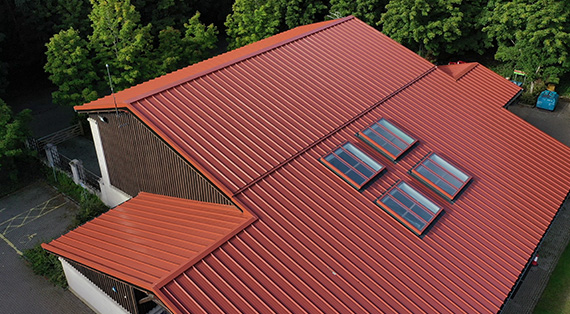
Common Roof Application Defect – Solutions
To ensure the best possible installation of your roofing system always:
- Use experienced manufacturing experts – Ensure that your roofing system has been specified by a roofing technical expert and that a comprehensive survey and evaluation of the site has been carried out.
- Use skilled contractors - Ensure your roofing manufacturer provides training and ongoing CPD to your chosen contractors.
- Be mindful of weather conditions.
- Arrange quality assurance inspections by experts - Your roofing manufacturer should have the expertise to assist you with this.
Written by Mark Fisher, Head of Technical at Garland UK
Garland are running a free roofing CPD event, to find out more and register your place click here, they can also be accessed by all public sector organisations for roofing projects through the Roofing Systems and Associated Works (RS4) framework
